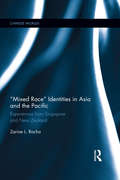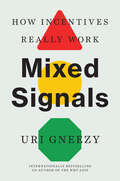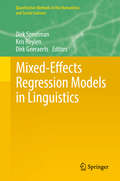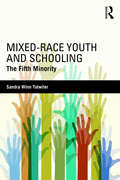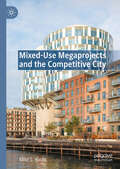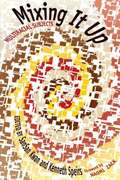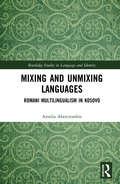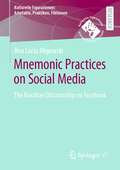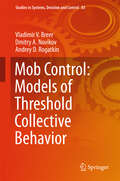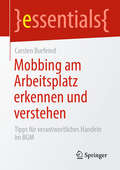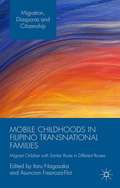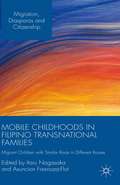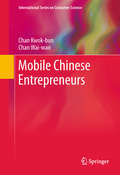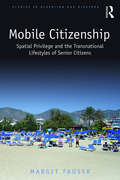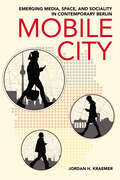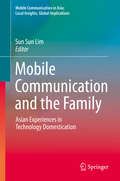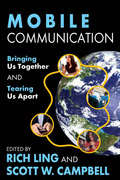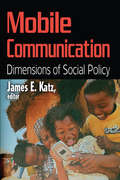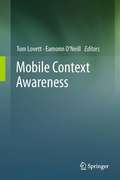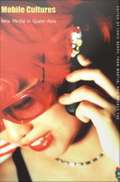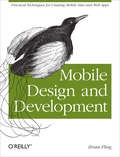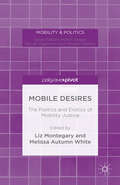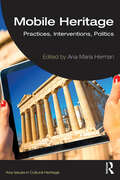- Table View
- List View
Mixed Race Identities in Asia and the Pacific: Experiences from Singapore and New Zealand (Chinese Worlds)
by Zarine L. Rocha"Mixed race" is becoming an important area for research, and there is a growing body of work in the North American and British contexts. However, understandings and experiences of "mixed race" across different countries and regions are not often explored in significant depth. New Zealand and Singapore provide important contexts for investigation, as two multicultural, yet structurally divergent, societies. Within these two countries, "mixed race" describes a particularly interesting label for individuals of mixed Chinese and European parentage. This book explores the concept of "mixed race" for people of mixed Chinese and European descent, looking at how being Chinese and/or European can mean many different things in different contexts. By looking at different communities in Singapore and New Zealand, it investigates how individuals of mixed heritage fit into or are excluded from these communities. Increasingly, individuals of mixed ancestry are opting to identify outside of traditionally defined racial categories, posing a challenge to systems of racial classification, and to sociological understandings of "race". As case studies, Singapore and New Zealand provide key examples of the complex relationship between state categorization and individual identities. The book explores the divergences between identity and classification, and the ways in which identity labels affect experiences of "mixed race" in everyday life. Personal stories reveal the creative and flexible ways in which people cross boundaries, and the everyday negotiations between classification, heritage, experience, and nation in defining identity. The study is based on qualitative research, including in-depth interviews with people of mixed heritage in both countries. Filling an important gap in the literature by using an Asia/Pacific dimension, this study of race and ethnicity will appeal to students and scholars of mixed race studies, ethnicity, Chinese diaspora and cultural anthropology.
Mixed Race in Asia: Past, Present and Future (Routledge Research in Race and Ethnicity)
by Zarine L. Rocha and Farida FozdarMixed racial and ethnic identities are topics of increasing interest around the world, yet studies of mixed race in Asia are rare, despite its particular salience for Asian societies. Mixed Race in Asia seeks to reorient the field to focus on Asia, looking specifically at mixed race in China, Japan, Korea, Indonesia, Malaysia, Singapore, Vietnam and India. Through these varied case studies, this collection presents an insightful exploration of race, ethnicity, mixedness and belonging, both in the past and present. The thematic range of the chapters is broad, covering the complexity of lived mixed race experiences, the structural forces of particular colonial and post-colonial environments and political regimes, and historical influences on contemporary identities and cultural expressions of mixedness. Adding significant richness and depth to existing theoretical frameworks, this enlightening volume develops markedly different understandings of, and recognizes nuances around, what it means to be mixed, practically, theoretically, linguistically and historically. It will appeal to undergraduate and postgraduate students, as well as postdoctoral and other researchers interested in fields such as Race and Ethnicity, Sociology and Asian Studies.
Mixed Signals: How Incentives Really Work
by Uri GneezyAn informative and entertaining account of how actions send signals that shape behaviors and how to design better incentives for better results in our life, our work, and our world Incentives send powerful signals that aim to influence behavior. But often there is a conflict between what we say and what we do in response to these incentives. The result: mixed signals. Consider the CEO who urges teamwork but designs incentives for individual success, who invites innovation but punishes failure, who emphasizes quality but pays for quantity. Employing real-world scenarios just like this to illustrate this everyday phenomenon, behavioral economist Uri Gneezy explains why incentives often fail and demonstrates how the right incentives can change behavior by aligning with signals for better results. Drawing on behavioral economics, game theory, psychology, and fieldwork, Gneezy outlines how to be incentive smart, designing rewards that are simple and effective. He highlights how the right combination of economic and psychological incentives can encourage people to drive more fuel-efficient cars, be more innovative at work, and even get to the gym. &“Incentives send a signal,&” Gneezy writes, &“and your objective is to make sure this signal is aligned with your goals.&”
Mixed-Effects Regression Models in Linguistics
by Dirk Geeraerts Dirk Speelman Kris HeylenWhen data consist of grouped observations or clusters, and there is a risk that measurements within the same group are not independent, group-specific random effects can be added to a regression model in order to account for such within-group associations. Regression models that contain such group-specific random effects are called mixed-effects regression models, or simply mixed models. Mixed models are a versatile tool that can handle both balanced and unbalanced datasets and that can also be applied when several layers of grouping are present in the data; these layers can either be nested or crossed. In linguistics, as in many other fields, the use of mixed models has gained ground rapidly over the last decade. This methodological evolution enables us to build more sophisticated and arguably more realistic models, but, due to its technical complexity, also introduces new challenges. This volume brings together a number of promising new evolutions in the use of mixed models in linguistics, but also addresses a number of common complications, misunderstandings, and pitfalls. Topics that are covered include the use of huge datasets, dealing with non-linear relations, issues of cross-validation, and issues of model selection and complex random structures. The volume features examples from various subfields in linguistics. The book also provides R code for a wide range of analyses.
Mixed-Occupancy Housing in London: A Living Tapestry (Essays In Honour Of Hermínio Martins)
by Gary Armstrong James Rosbrook-ThompsonThis ethnographic study of a mixed-occupancy housing estate near the centre of London refocuses the scholarly conversation around social housing in the UK after the 1980 Housing Act. As well as examining the long-term consequences of ‘Right to Buy,’ such as shortages in local authority stock and neighbourhood gentrification, James Rosbrook-Thompson and Gary Armstrong investigate the changes wrought on the social fabric of the individual estate. Drawing on four years of ethnographic fieldwork, the authors explore the estate’s social mix and, more specifically, the consequences of owner-occupiers, council tenants and private renters sharing a cramped inner-city neighbourhood. Mixed-Occupancy Housing in London: A Living Tapestry humanizes the academic discussion of class, race, and gender in social housing through the occupants’ tales of getting by, getting along and getting out.
Mixed-Race Youth and Schooling: The Fifth Minority
by Sandra Winn TutwilerThis timely, in-depth examination of the educational experiences and needs of mixed-race children ("the fifth minority") focuses on the four contexts that primarily influence learning and development: the family, school, community, and society-at-large. The book provides foundational historical, social, political, and psychological information about mixed-race children and looks closely at their experiences in schools, their identity formation, and how schools can be made more supportive of their development and learning needs. Moving away from an essentialist discussion of mixed-race children, a wide variety of research is included. Life and schooling experiences of mixed-raced individuals are profiled throughout the text. Rather than pigeonholing children into a neat box of descriptions or providing readymade prescriptions for educators, Mixed-Race Youth and Schooling offers information and encourages teachers to critically reflect on how it is relevant to and helpful in their teaching/learning contexts.
Mixed-Use Megaprojects and the Competitive City
by Mike S. HarrisThis book examines the motives and outcomes of competitively positioned mixed-use megaprojects on government-owned land. These projects have emerged worldwide in recent decades, driven by urban international competition, the mobility and expansion of knowledge economies, the shift of global investment from physical to human capital, and the prevalence of market-driven or entrepreneurial politics. Six case studies across three countries are analysed through five themes: Positioning, Governing, Shaping, Connecting, and Public Benefit. While pursuing similar objectives of attracting mobile capital, each project operates within a specific political, financial and social context. These projects reflect the prevailing development practices and underlying power structures of cities and states. Throughout the implementation process, they can also reveal the power struggles and competing agendas within a city. In this manner, they serve as a valuable lens for understanding the political, economic, and cultural dynamics of a city, and how urban morphology manifests these processes.
Mixing It Up: Multiracial Subjects
by Sansan Kwan Kenneth SpeirsThe United States Census 2000 presents a twenty-first century America in which mixed-race marriages, cross-race adoption, and multiracial families in general are challenging the ethnic definitions by which the nation has historically categorized its population. Addressing a wide spectrum of questions raised by this rich new cultural landscape, Mixing It Up brings together the observations of ten noted voices who have experienced multiracialism first-hand.<P><P>From Naomi Zack's "American Mixed Race: The United States 2000 Census and Related Issues" to Cathy Irwin and Sean Metzger's "Keeping Up Appearances: Ethnic Alien-Nation in Female Solo Performance," this diverse collection spans the realities of multiculturalism in compelling new analysis. Arguing that society's discomfort with multiracialism has been institutionalized throughout history, whether through the "one drop" rule or media depictions, SanSan Kwan and Kenneth Speirs reflect on the means by which the monoracial lens is slowly being replaced.
Mixing and Unmixing Languages: Romani Multilingualism in Kosovo (Routledge Studies in Language and Identity)
by Amelia AbercrombieMixing and Unmixing Languages uses the politics and practices of language to understand social hierarchies and social change in a post-conflict and post-socialist context. The book focuses on Roma in Prizren, Kosovo, where the author conducted long-term ethnographic fieldwork, using language learning as a central method. Shifts in language practices among this highly multilingual group have reflected the demise of Yugoslav socialism, the rise of ethno-nationalist politics and conflict, and the post-war reversal of power relations in Kosovo. Roma in Prizren nostalgically narrate a past of cosmopolitanism and employment in contrast to the present. Their position today is complex: while they stress their relative integration, this position is fragile in the face of nationalist politics and imported neoliberal economic policies. Within this context, Roma NGO workers have found an economic niche working on projects to protect multiculturalism and minorities, funded by international aid agencies, centred on Romani language. This book discusses the historical trajectory and current configurations of a Romani organisation in the town, the standardisation of Romani and the hierarchical organisation of linguistic forms and language learning, the self-representation of Roma and the ‘gypsy’ image through Romani-language drama, and attitudes to purism, mixing and cosmopolitanism. Mixing and Unmixing Languages is suitable for academics and students in the areas of linguistic anthropology and linguistic ethnography, Romani studies, South-East European studies and sociolinguistics.
Mnemonic Practices on Social Media: The Brazilian Dictatorship on Facebook (Kulturelle Figurationen: Artefakte, Praktiken, Fiktionen)
by Ana Lúcia Migowski da SilvaThis book reflects on discourses about the Brazilian dictatorship (1964-1985) on social media. It examines entanglements between technological and mnemonic practices regarding this historical period. Following Olick and Robbins’ (1998) Historical Sociology of Mnemonic Practices, the book analyses more than what social actors say about the past. It explores the externalisation of knowledge about the past based on interactions identified on Facebook. Through this platform, it was possible to map and collect posts, comments, and reactions related to the historical period. This sample reveals perceptions and attitudes of social media users toward the past. The book also discusses socio-technical matters grounding mnemonic practices observed on Facebook. The concept of mnemonic affordance served as a conceptual tool for understanding situational elements involved in what users perceive that they can do on Facebook while articulating meanings about the past. The close analysis of two affordances indicates specificities in the performance of mnemonic practices on Facebook. These issues shed light on struggles for legitimacy regarding memories of the dictatorship and their impact on traditional regimes of knowledge and current public affairs in Brazil.
Mob Control: Models of Threshold Collective Behavior
by Vladimir V. Breer Dmitry A. Novikov Andrey D. RogatkinThis book presents mathematical models of mob control with threshold (conformity) collective decision-making of the agents. Based on the results of analysis of the interconnection between the micro- and macromodels of active network structures, it considers the static (deterministic, stochastic and game-theoretic) and dynamic (discrete- and continuous-time) models of mob control, and highlights models of informational confrontation. Many of the results are applicable not only to mob control problems, but also to control problems arising in social groups, online social networks, etc. Aimed at researchers and practitioners, it is also a valuable resource for undergraduate and postgraduate students as well as doctoral candidates specializing in the field of collective behavior modeling.
Mobbing am Arbeitsplatz erkennen und verstehen: Tipps für verantwortliches Handeln im BGM (essentials)
by Carsten BurfeindIn diesem essential gibt Carsten Burfeind einen Überblick über alle relevanten Aspekte des komplexen Geschehens „Mobbing am Arbeitsplatz“. Es wird deutlich, dass die Reduktion psychischer Belastungen die beste Mobbingprävention darstellt, denn Stress fördert Mobbing und Mobbing stresst, und dass der Schutz der Betroffenen Vorrang vor anderen betrieblichen Maßnahmen hat. Das Buch enthält Tipps und Hinweise für verantwortliches Handeln im konkreten Mobbingfall und gibt den Leserinnen und Lesern Handlungsempfehlungen für eine betriebliche Konflikt- und Mobbingprävention.
Mobile Childhoods in Filipino Transnational Families: Migrant Children with Similar Roots in Different Routes (Migration, Diasporas and Citizenship)
by Asuncion Fresnoza-Flot Itaru NagasakaMobile Childhoods in Filipino Transnational Families focuses on the lived experiences of '1.5-generation' migrants with similar 'roots' (the Philippines), traversing different 'routes' (receiving countries). By shedding light on the diversified paths of their migratory lives, it revisits the relationships between mobility, sociality and identity.
Mobile Childhoods in Filipino Transnational Families: Migrant Children with Similar Roots in Different Routes (Migration, Diasporas and Citizenship)
by Asuncion Fresnoza-Flot Itaru NagasakaMobile Childhoods in Filipino Transnational Families focuses on the lived experiences of '1.5-generation' migrants with similar 'roots' (the Philippines), traversing different 'routes' (receiving countries). By shedding light on the diversified paths of their migratory lives, it revisits the relationships between mobility, sociality and identity.
Mobile Chinese Entrepreneurs
by Chan Kwok-Bun Chan Wai-WanMobile Chinese Entrepreneurs draws extensively on the narratives of sixteen small-to-medium business owners, born on the mainland, who have immigrated to Hong Kong and returned to their ancestral hometowns in China to establish their enterprises. For these executives, business and social life alike are marked by constant interplay of identities, such as individual identity/group membership and ancestral/immigrant identity. Yet as often as this juggling of multiple "selves" can be beneficial in the economic sphere, it can also lead to feelings of rootlessness and alienation. Writing with rare sensitivity, the two authors synthesize insights from economic sociology, psychology, ethnic relations, emotions, and social networks, creating an exploration of social capital and social identity comparable to similar groups of businessmen and -women in other parts of the world.
Mobile Citizenship: Spatial Privilege and the Transnational Lifestyles of Senior Citizens (Studies in Migration and Diaspora)
by Margit FauserMobile Citizenship addresses the crucial question of how mobility reconfigures citizenship. Engaging with debates on transnationalism, citizenship, and lifestyle migration, the book draws on ethnographic research and interview material collected among retired lifestyle migrants moving south from Germany to Turkey to explore the practices and narratives of these privileged migrants. Revealing the ways in which these migrants relate to their old homes and to their new places, the author examines the social, political, and spatial dimensions of citizenship and belonging and argues that citizenship is key to understanding the privileges of transnational lifestyles. By taking up discussions emanating from studies on other privileged lifestyle migrations—around social welfare and well-being, social participation, and affective belonging, as well as class and racialized privileges—the book exposes particular comparative value and showcases similarities and differences across this emerging type of migration. Mobile Citizenship thus shows how citizenship allows for mobility, resources, and privilege yet is also replete with limitations and ambivalences. The book brings together perspectives on citizenship, space, and privilege and will appeal to social scientists with interests in lifestyle migration and citizenship and their interconnections with global and social inequalities.
Mobile City: Emerging Media, Space, and Sociality in Contemporary Berlin
by Jordan H. KraemerIn Mobile City, Jordan H. Kraemer charts the rise of social media and an emerging "knowledge" class in early-2000s Berlin. Many young Germans and EU-Ausländer (foreigners from other EU countries), attracted to Berlin's vibrant post-unification counterculture, moved to the city just as they began using social media like Facebook and Twitter. Social media and Berlin alike became hip sites for urban, middle-class aspirations, but, as Kraemer accounts, social media users became embroiled in contestations over class mobility and identity, as urban planners and developers remade Berlin into a neoliberal "creative city."The rise of this creative city involved scale-making projects that fused imaginaries of digital technologies with the expansive impulses of late capital: a vision of world peace and economic cooperation through global interconnection. But in Berlin, scalar transformations were lived out through ordinary practices that reconfigured daily sociality, mobility, and urban space. Mobile City explores how digital media practices forged emergent scales like the global and supranational yet were equally complicit in potential European disintegration and illiberalism.
Mobile Communication and the Family
by Sun Sun LimThis volume captures the domestication of mobile communication technologies by families in Asia, and its implications for family interactions and relationships. It showcases research on families across a spectrum of socio-economic profiles, from both rural and urban areas, offering insights on children, adolescents, adults, and the elderly. While mobile communication diffuses through Asia at a blistering pace, families in the region are also experiencing significant changes in light of unprecedented economic growth, globalisation, urbanisation and demographic shifts. Asia is therefore at the crossroads of technological transformation and social change. This book analyses the interactions of these two contemporaneous trends from the perspective of the family, covering a range of family types including nuclear, multi-generational, transnational, and multi-local, spanning the continuum from the media-rich to the media have-less.
Mobile Communication: Bringing Us Together and Tearing Us Apart (Digital Media And Society Ser. #31)
by Scott CampbellMobile Communication covers a wide range of topics. These include the replacement of co-present interaction with mediated contact and analysis of mobile-based cohesion and gender. The authors also explore the role of media choice and its effect on the quality as well as quantity of social cohesion. Other topics include mobile communication and communities of interest; and mobile communication, cohesion, and youth.This volume brings together scholars from around the world to consider how mobile communication both builds and destroys our sense of social cohesion. There is no question that uses of technology can lead to increased cohesion within personal communities. For example, this volume includes research on caravan couples in Australia, factory workers in China, young couples in Germany, citizens in Slovenia, and sports clubs in Ireland. It also includes research on drunken calls between university students in the US, calls of international students in Switzerland and communications between immigrant women in Melbourne, Australia.However, the contributors also argue that as social networks become inundated with mobile communication users, these users may become increasingly isolated and social division can ensue.
Mobile Communication: Dimensions of Social Policy
by James E. KatzIn the few short decades since their commercial deployment, 5 billion people—about three-quarters of all humanity, including children—have become mobile phone users. No technology has even approached the mobile phone's wildfire success. Effects of this success are apparent everywhere, ranging from accident scenes and earthquake rescue efforts to demeanor in the classroom and at dinner tables. No one interested in the next generation of issues provoked by the mobile communication revolution will want to miss this important new collection of essays.The mobile phone has given near-transcendent power to ordinary people. All aspects of social life have been touched by mobile technology. An ever-growing host of tracking, immersion, gaming, and commercial applications are becoming available. The community of mobile communication scholars has blossomed from a handful of pioneers a decade ago to a large and dynamic intellectual community that spans the globe. Area researchers have gained much insight into cultural, symbolic, and social interaction aspects of mobile communication as well as its relevance to commerce.To address the social policy dimension of the mobile communication revolution, this volume presents analyses by leading thinkers in the field. The volume offers novel and keen insights into the topic. Subjects include the role of mobiles in policy formation and evaluation in several areas including the mobile-digital divide and political campaigns. Also explored are processes and policy implications of mobiles in creating or alleviating social problems including social isolation and family dispersion. Other chapters analyze social policies for mobile devices, including attempts to regulate the use of the technology and to understand and moderate its potential harm to human health. The contributors' scope ranges across five continents and they address concerns at local, national, and international levels.
Mobile Context Awareness
by Tom Lovett Eamonn O'NeillMobile context-awareness is a popular research trend in the field of ubiquitous computing. Advances in mobile device sensory hardware and the rise of 'virtual' sensors such as web application programming interfaces (APIs) mean that the mobile user is exposed to a vast range of data that can be used for new advanced applications. Mobile Context Awareness presents work from industrial and academic researchers, focusing on novel methods of context acquisition in the mobile environment - particularly through the use of physical and virtual sensors - along with research into new applications utilising this context. In addition, the book provides insights into the technical and usability challenges involved in mobile context-awareness, as well as observations on current and future trends in the field.
Mobile Cultures: New Media in Queer Asia
by Chris Berry Audrey Yue Fran MartinMobile Cultures provides much-needed, empirically grounded studies of the connections between new media technologies, the globalization of sexual cultures, and the rise of queer Asia. The availability and use of new media--fax machines, mobile phones, the Internet, electronic message boards, pagers, and global television--have grown exponentially in Asia over the past decade. This explosion of information technology has sparked a revolution, transforming lives and lifestyles, enabling the creation of communities and the expression of sexual identities in a region notorious for the regulation of both information and sexual conduct. Whether looking at the hanging of toy cartoon characters like "Hello Kitty" from mobile phones to signify queer identity in Japan or at the development of queer identities in Indonesia or Singapore, the essays collected here emphasize the enormous variance in the appeal and uses of new media from one locale to another. Scholars, artists, and activists from a range of countries, the contributors chronicle the different ways new media galvanize Asian queer communities in Taiwan, South Korea, Japan, Indonesia, Thailand, Malaysia, India, and around the world. They consider phenomena such as the uses of the Internet among gay, lesbian, or queer individuals in Taiwan and South Korea; the international popularization of Japanese queer pop culture products such as Yaoi manga; and a Thai website's reading of a scientific tract on gay genetics in light of Buddhist beliefs. Essays also explore the politically subversive possibilities opened up by the proliferation of media technologies, examining, for instance, the use of Cyberjaya--Malaysia's government-backed online portal--to form online communities in the face of strict antigay laws. Contributors. Chris Berry, Tom Boellstorff, Larissa Hjorth, Katrien Jacobs, Olivia Khoo, Fran Martin, Mark McLelland, David Mullaly, Baden Offord, Sandip Roy, Veruska Sabucco, Audrey Yue
Mobile Design and Development: Practical concepts and techniques for creating mobile sites and web apps (Animal Guide)
by Brian FlingMobile devices outnumber desktop and laptop computers three to one worldwide, yet little information is available for designing and developing mobile applications. Mobile Design and Development fills that void with practical guidelines, standards, techniques, and best practices for building mobile products from start to finish. With this book, you'll learn basic design and development principles for all mobile devices and platforms. You'll also explore the more advanced capabilities of the mobile web, including markup, advanced styling techniques, and mobile Ajax. If you're a web designer, web developer, information architect, product manager, usability professional, content publisher, or an entrepreneur new to the mobile web, Mobile Design and Development provides you with the knowledge you need to work with this rapidly developing technology. Mobile Design and Development will help you:Understand how the mobile ecosystem works, how it differs from other mediums, and how to design products for the mobile contextLearn the pros and cons of building native applications sold through operators or app stores versus mobile websites or web appsWork with flows, prototypes, usability practices, and screen-size-independent visual designsUse and test cross-platform mobile web standards for older devices, as well as devices that may be available in the futureLearn how to justify a mobile product by building it on a budget
Mobile Desires: The Politics and Erotics of Mobility Justice (Mobility & Politics)
by Liz Montegary Melissa Autumn WhiteThis book combines mobilities research with feminist and queer studies offering new perspectives on mobility justice. It foregrounds academic, activist, and artistic work revealing state-sponsored strategies for managing the mobility of people as mechanisms for aligning erotic and political desires with capitalist and nationalist interests.
Mobile Heritage: Practices, Interventions, Politics (Key Issues in Cultural Heritage)
by Ana-Maria HermanMobile Heritage explores how diverse digital technologies (such as apps, GPS, games, social platforms, NFTs, drones, AR, MR and AI, among others) have allowed for new types of mobilities and introduced a novel set of practices, interventions, and politics for heritage collections, archives, exhibitions, entertainment, conservation, management, commerce, education, restitution, activism, and regulation.The volume is not a ‘how to’ book. Instead, it critically examines this emerging landscape and its unsettling of existing relations between heritage and knowledge, value, identity, power, sense of place, community, nationhood, and ownership – thus outlining a new set of issues, implications, and consequences. The volume brings together case studies from around the world and each chapter considers mobility matters associated with tangible and intangible cultural heritage (relating to art, film, music, games, manuscripts, traditional knowledge, architecture, cities, and more) and the involvement of a variety of actors in digital heritage practices and interventions (such as artists, activists, communities, museums, non-profit organisations, educational institutions, enterprises and governmental agencies). The contributors are scholars and practitioners drawing on various disciplines and fields of study, including archaeology, museum studies, media studies, computing, art history, cultural studies, anthropology, gender studies, mobility studies, and law.Mobile Heritage positions mobility as a critical tool for understanding the changing (digital) heritage landscape, making this volume an essential read for students, academics, and practitioners engaged in this area.
